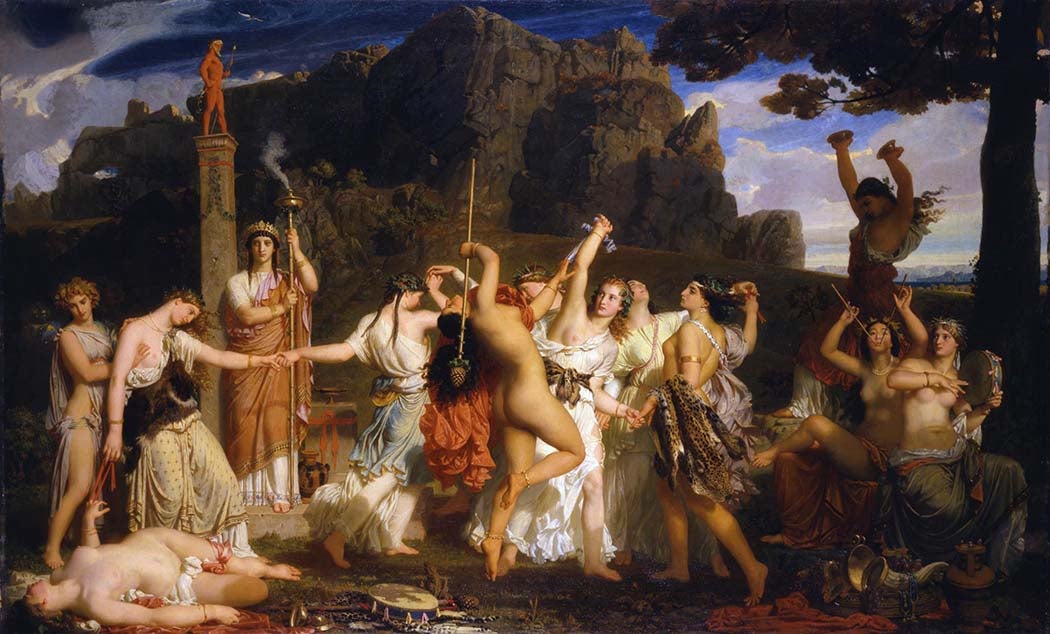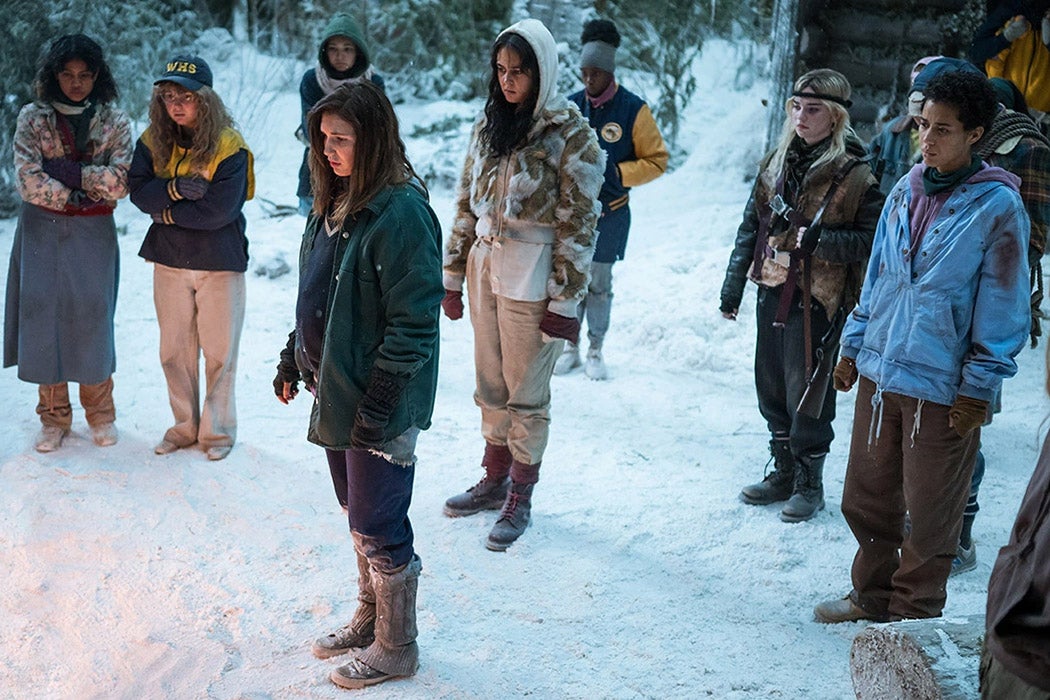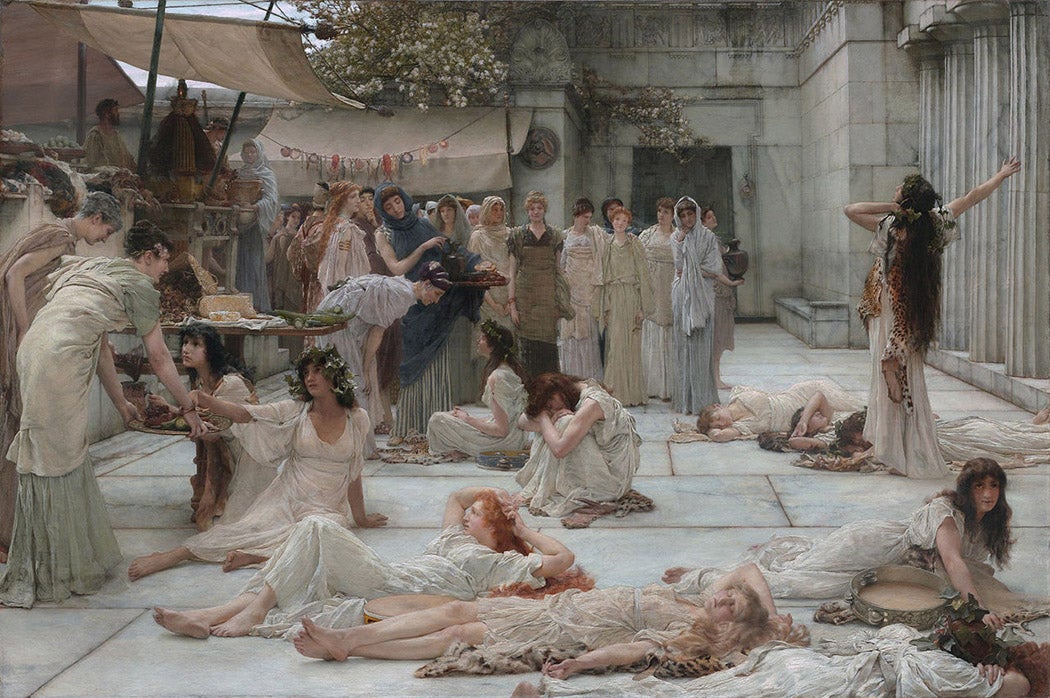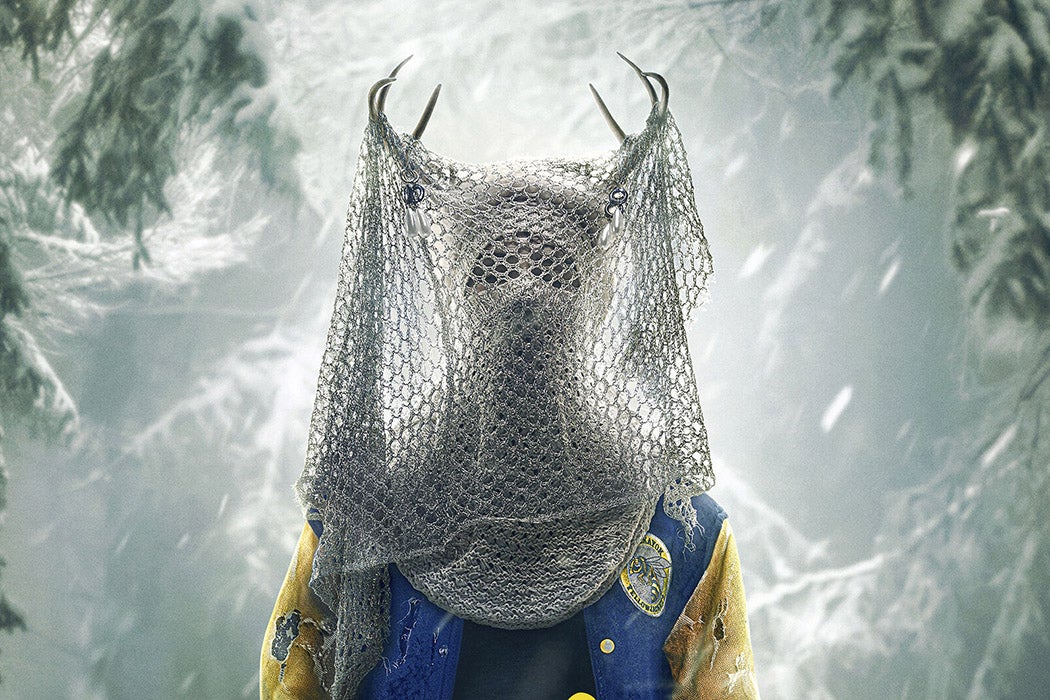Forget the hype likening Showtime’s Yellowjackets to Lord of the Flies. Pungent, witty, and downright disgusting, the hit series about a high school soccer team whose plane crashes in the Canadian wilderness is far more than a rigid gender swap. Yellowjackets, set to launch its second season this Friday, toggles between the past and the present, showing how the girls cope—or fail to—with their trauma. Featuring characters within whom savagery rages, the innovative program takes on maenadism—the practices of frenzied women, called maenads, who performed horrific rites to worship Dionysus (or Bacchus), the god of wine.
Inextricably interwoven throughout the first season generally, and episode nine specifically, are subtle yet significant references to maenadism and Dionysian rituals. The premiere offers glimpses of a harrowing cult. Crash survivors engage in cannibalistic hunting rites. We hear inhuman screams, indiscernible whispers, ominous symbols, and spectral caws. The series’ very name and the name of the soccer team link the girls to the Greek god. Different from the flies invoked in the title of William Golding’s novel, yellowjackets, like other wasps, are renowned for their love of wine grapes. The girls’ transition from simply being bearers of the name of these deadly creatures to being agents of unscrupulous, uninhibited behavior encompasses this maenadic journey. Furthermore, these nods to Greek and Roman literature are not brief allusions; they make up a significant and essential component of the series’ tone, structure, and trajectory.
Weekly Newsletter
Maenads, in the Classical period, were initially restricted to domestic responsibilities. They liberated themselves and escaped home through Dionysian worship, and are therefore linked to “disruption or inversion,” as Jan N. Bremmer asserts in “Greek Maenadism Reconsidered.” Through its submersion in these same waters, Yellowjackets enables a subversion of the toxic school and home environments which, viewers come to understand, are the standard for most of the characters before the crash. This subversion culminates in the ninth episode of season one, as the girls meticulously plan a “Doomcoming” party whose lunar ambiance forebodes total aberrance.

In the preparation process itself, the girls’ progression into full-blown maenads becomes clear. They carefully, tenderly make wreaths, antlers, and decorations for themselves to wear; these adornments invoke the maenadic dress code. Taissa (played by Jasmin Savoy Brown), one of the team’s stars, fashions two ornate leather masks so she and Van (Liv Hewson), her teammate and romantic interest, will match at the party. Van’s face is scarred from a violent wolf attack, and she is embarrassed by and self-conscious about her disfigurement. Masks are associated with Dionysus and his playfulness, and in Yellowjackets they play an vital role in facilitating this queer relationship; wearing them, Taissa and Van enter the party hand-in-hand and share an intimate kiss in front of the others. Maenadism is tailored to the specific circumstances of Yellowjackets’ individual characters, enabling each in her own way to deviate from normative society.
What starts as an innocent celebration soon takes a sharp turn, as the girls drink a brew spiked with psychoactive mushrooms and fermented berries. They suddenly ooze with ecstasy; they butcher conventions of decency and propriety. Before long the teens are stretched out on the ground, fallen, an act that signifies the Dionysian possession of the worshiper. Brute laughter, distorted visions, and chaos descend and erupt. The party morphs into a bacchanalia.
In the year 405 B.C.E., Euripides’ Bacchae premiered. It tells the story of Dionysus’ revenge upon King Pentheus, his mortal cousin, and Agave, Pentheus’ mother, who deny that Dionysus is the son of Zeus. A messenger tells Pentheus of the maenads, “the women who ran barefoot and crazy,” and of their feralness: “One woman struck her thyrsus against a rock and a fountain of cool water came bubbling up. Another drove her fennel in the ground, and where it struck the earth, at the touch of god, a spring of wine poured out. Those who wanted milk scratched at the soil with bare fingers and the white milk came welling up.” So too in Yellowjackets, when Shauna (Sophie Nelisse), the show’s ostensible heroine, scrapes the soil with her hands and milk trickles out.
Indeed the Pentheus myth is the series’ intrinsic glue. Travis (Kevin Alves), one of its few male characters and the son of the team’s coach, metamorphoses into a stag in the girls’ mass hallucination. A pinecone is stuffed in his mouth, recalling the thyrsus carried by Dionysian worshipers, which has a pinecone on its top. The girls attempt to tear him apart and simultaneously devour him in a contemporary enactment of the ritual of sparagmos, as it’s called in ancient Greek myth.
Monstrosity and horror saturate the maenadic rituals the Yellowjackets (the soccer team, that is) perform in the wilds. There is, for instance, the gluttonous, intoxicating drinking, and the ghastly howls the girls unleash as they hunt Travis. There are also visual distortions that exponentiate the grotesquerie; the maenads’ bared, stained, and menacing teeth, their aggressive, hungry eyes, and their violent bodies—they rip apart not only Travis’ clothes but tear his very skin.

Unapologetic in its rejection of discretion regarding gore, the series inculcates Julia Kristeva’s theory of the abject wherein a transgression of boundaries between subjectivity and objectivity, the self and the other, is enabled. Jela Krečič and Slavoj Žižek’s take on this theory resonates throughout Yellowjackets, which employs horror in radical fashion. “What we fear in an open wound or a dead body is not its ugliness but the blurring of the line between inside and outside,” the two write. Rupturing the viewer’s passive gaze, Yellowjackets’ gut-wrenching barbarity is situated in these corporeal incisions and dissections.
When viewers first meet adult Shauna (Melanie Lynskey) in the show’s first episode, they learn of her decided distaste for rabbits. It is peculiar then to see a montage of rabbit figurines in her kitchen; these statuettes are conspicuous in the backdrop for the entirety of her first conversation with a nosy reporter. Viewers then witness shocking brutality, as Shauna kills a rabbit foraging in her garden. In the second episode, Shauna goes a giant, gruesome step further, performing yet another sparagmos. Armed with a cleaver and a filet knife, she tears the rabbit apart, ripping its guts out and skinning it “chin to anus” as she herself describes, before serving it to her family for dinner, with a subtle, smug smile on her face.
Shauna’s facility with a corpse is a hat-tip to Dionysian acts of cannibalism, as are the animal pelts that the girls cover themselves in to guard against winter. The show affirms the truth of argument put forth by classics scholar E. R. Dodds’ that “the maenad, however mythical certain of her acts, is not in essence a mythological character but an observed and still observable human type.”

Distortions of the flesh, moreover, are interspersed with a non-normative focus on female reproductive systems. Menstruation, pregnancy, and virginity are all associated with horrific maenadic rituals. Teenage Shauna, as it turns out, is pregnant; during a trance at Doomcoming, she feels the fetus move. Meanwhile, Jackie (Ella Purnell), Shauna’s purported BFF, is determined to rid herself of her virginity; Jackie’s sexual encounter with Travis, in fact, sets the possessed maenadic figures off on their pursuit of him. Through these narrative arcs, Yellowjackets exposes and challenges the hollowness prevalent in the delicacy and passivity with which women and girls are generally represented.
The wine at Doomcoming is of a piece with fermented and naturally occurring substances that prevailed in Dionysian rituals of the Classical period. According to Carl Ruck, “maenadic rites involved such gathering of plants, which were used as psychotropic additives to the sacred wine.” Thusly fuel, the girls storm the world of non-normativity, a realm that clamors for a literal dismemberment of heteropatriarchal mechanisms through queer erotics. These come to the fore piquantly with Taissa and Van, as well as with the coach’s assertion of his gay identity.

The explicit sounds that animate the series highlight the transgressions induced by the girls’ hallucinations. A harrowing chorus of voices mark powerful narrative transitions within episodes. The soundtrack’s “Join Hands / With The Angels” suggests the intensity of a cult ritual being performed. And the drum beats, guitar riffs, and haunting vocals in “No Return,” the show’s title song, conjure a dream-like, or nightmare-ish, soundscape.
The opening title sequence offers a frenzied psychedelic montage on a glitched VHS tape. In a pinched set of edits, viewers see disfigured characters, hair-raising stares, vomit, maggots, and spectral elements in a sequence that grows ever more intense and aggressive. The sequence disrupts standardized ideals through which women are dominantly represented. Plus, the haphazard rewinds, haunting, hazy pauses, and crackling transitions foreshadow the show’s distortion of linear time. Tacking as it does between New Jersey in 2021 and Canada in 1996, the series continually disrupts the demarcation of time into tidy categories of past, present, and future through memory, hallucination, and conversation.
In each timeline, the myth of Pentheus is refashioned. In 2021, Shauna stabs her lover, Adam, wrongly thinking that he is blackmailing her—that he is not what he appears to be, just like the mythological maenads who saw Pentheus as an animal, and not human. In this instant of violence, Shauna’s past and present selves collide. She’s seemingly possessed in a hostile trance-like state; it is downright Dionysian. Her former teammates, now adults, come together and perform an altered, utilitarian sparagmos to dispose of Adam’s corpse. That’s not all, though. Adam’s presence is a red herring, catalyzing an inversion of biblical mythology; here, chaos results not from any action of Eve’s, as in Genesis, but from Adam’s curiosity about Shauna’s past.
Weekly Newsletter
In 1996, Travis is the Pentheus stand-in, but in his arc, he is murdered not then and there in the wilderness, but in the future, in 2021, and his death is shrouded in allusions to cult symbols the girls saw years ago near the crash site. The wilds of the past have punctured the “normalcy” of the now. Time is rendered as a synchronous blend of moments, untethering and distorting any normative perspective.
In their original pitch for the series, Ashley Lyle and Bart Nickerson, Yellowjackets’ showrunners, described it as a “supernatural thriller, pitch-black coming of age comedy, gothic fairy-tale.” It discomforts viewers through its intense intertextual layers and defiance of the rigid parameters that typically prevail in remakes. Here, the remake is of a Greek myth whose very essence centers on rule-breaking and abandon. If the second season of Yellowjackets throbs with the same exhilarating brutality that drove the first, there is but one Greek god to thank.







